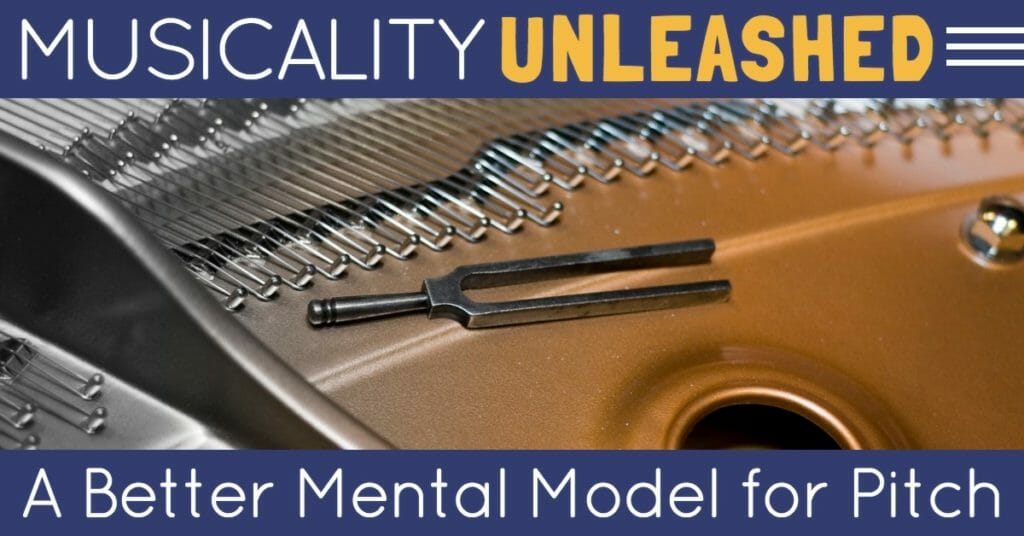This episode is part of the Musicality Unleashed series. Learn more and get a bonus “cheat sheet” at musicalityunleashed.com. In this episode, we delve into the oft-debated topic of how to learn pitch – and the answer doesn’t lie in intervals! Learn about the power of solfa and how it can help you understand the relationships between notes that is natural, intuitive, and simple.
Listen to the episode:
Subscribe For Future Episodes!
Enjoying the show? Please consider rating and reviewing it!
Links and Resources
- Solfege: Why Do Re Mi Isn’t Just Child’s Play
- Starting Solfa
- Musicality Unleashed: Did You Skip Step One?
Enjoying Musicality Now? Please support the show by rating and reviewing it!
Transcript
If you want to play notes by ear you can learn to – but don’t follow the common advice: intervals are not the solution.
Learning to recognise notes by ear is a dream for many musicians: to hear music and be able to name, play, or write down the notes you heard.
This isn’t magic – it’s a learnable skill. And it doesn’t take an innate “gift” like “perfect pitch”.
You can develop what’s called your “relative pitch” using simple proven exercises.
The most well-known approach uses what’s called “intervals”: training your ear to recognise the different distances between pitches such as a “major third” or “perfect fifth”.
The interval approach has some strengths but it’s actually not the best way to quickly learn a useful level of relative pitch.
What you find if you study intervals is that you can get very good at recognising intervals – but it’s then actually very difficult to put it into practice when you hear a real melody or try to improvise something.
Your brain just can’t think through and process each of the intervals fast enough.
And what’s worse: as soon as you hit an interval you don’t recognise, you lose your ability to name every note that follows – you’re lost.
If you want relative pitch to play by ear, write down music, improvise, or write your own music then there’s another approach that will get you there much faster and give you a much more reliable ability to recognise notes by ear.
It’s called “solfa” and you might have come across it as the “do-re-mi” system for naming notes.
I should mention this isn’t the same as the “solfege” system used in some European countries where “do” is always the note “C”, “re” is the same as “D”, and so on.
We’re talking about what’s called “movable do solfa”. It sometimes gets called “solfege” like the European “fixed do” system, which is where it can get confusing.
So I’ll be super clear: With “moveable do solfa”, we call the first note of the scale “do”, whether that note is C, D, E, G♯ E♭, and so on.
Okay, what does that have to do with relative pitch? Well, adopting this mental model for thinking about note pitches produces almost magical results in your ability to identify notes by ear.
That’s because solfa actually matches how your ear already understands music
Our ears tune in to the relative pitch distances between notes and the tonic, that first note of the scale – not the absolute pitches of notes.
This must be true because otherwise if the DJ on the radio sped up a song and all the pitches went up a bit, you’d hear it as a completely different song. In fact, we don’t even notice because our ears are tuned into the relative changes in pitch – and those haven’t changed.
If I sing the melody of “Mary Had a Little Lamb” [sing] and then sing it again starting on a different note [sing] you still hear it’s the same song – even though literally every note pitch has changed.
So that’s how our ear inteprets music already.
That means if your mental model matches up with that, you don’t need to start from scratch to develop your relative pitch skills.
You can leverage the work you’ve already been doing for years, passively training your ears to understanding instinctively how music works.
The result is that learning the solfa mental model can be done fast – we’re talking a few weeks to get to a decent standard – and pays off immediately.
This means that it’s far more effective and rewarding than the interval approach for the practical skills like playing by ear or improvising.
As I said before, intervals aren’t wrong or bad – they have real strengths in certain contexts and the great thing is they’re totally compatible with and complimentary to solfa, so you don’t need to choose one or the other.
But if you want to learn relative pitch and name and play notes easily by ear, adopt solfa as your mental model and you’ll be able to take advantage of the existing ear skills you didn’t know you had – and go far fast.
That’s one example of a mental model that you can put in place to quickly find new freedom in music. Learn more in the rest of this Musicality Unleashed series.
Subscribe For Future Episodes!
Enjoying the show? Please consider rating and reviewing it!







